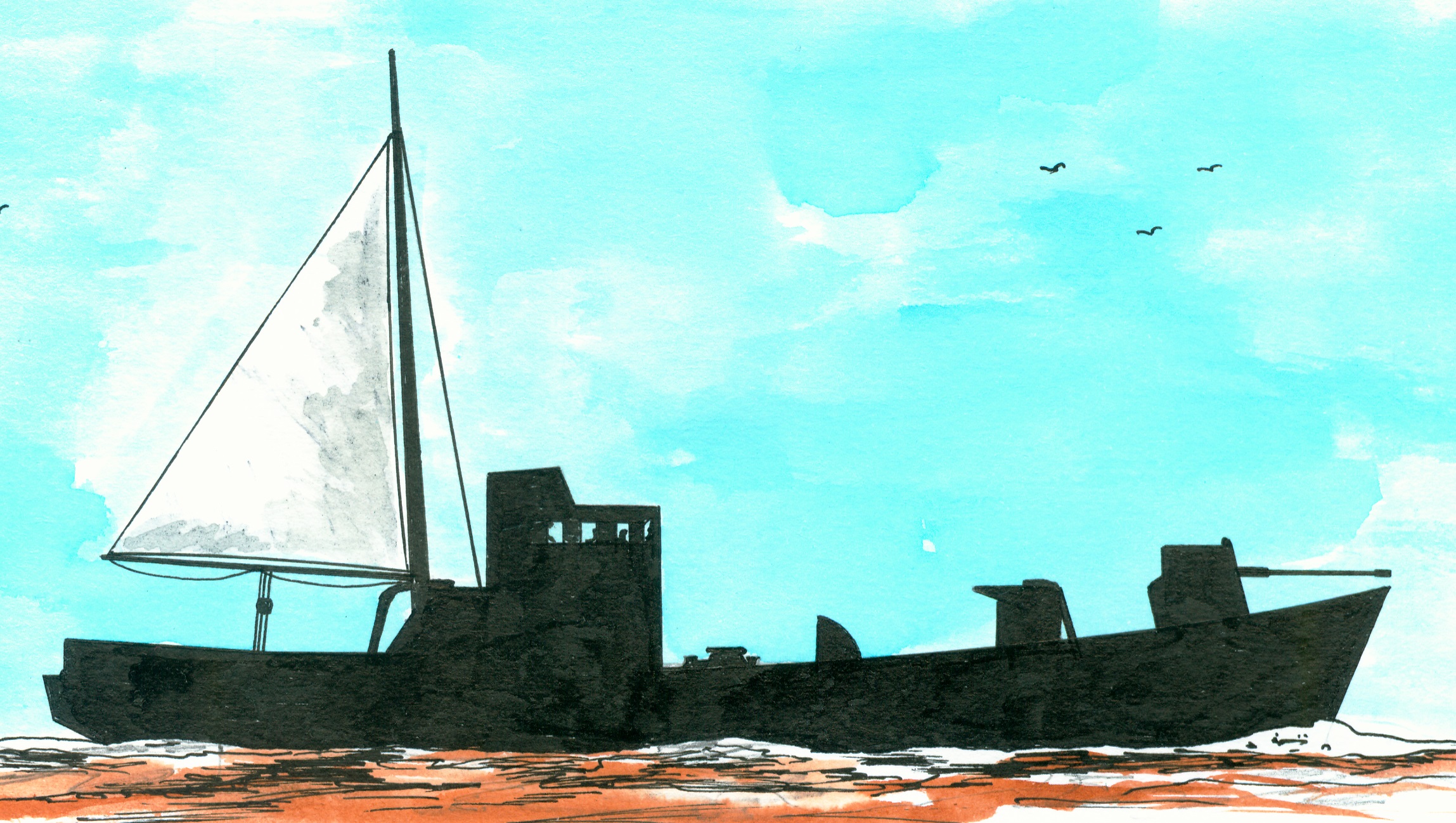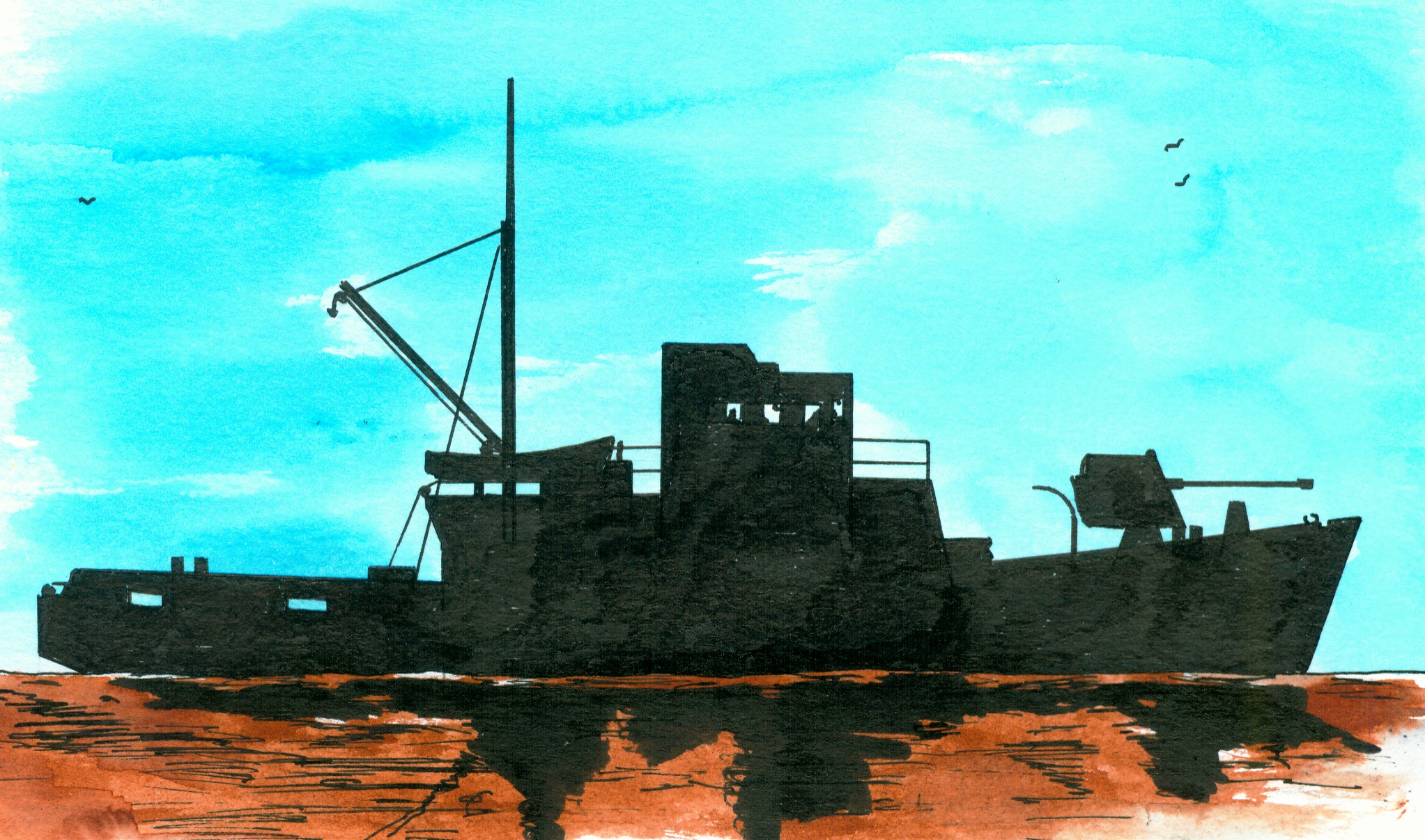Preliminary design I
Preliminary design II
Artists impression when converted into a fishing vessel
On 13 October 1949 confirmed the Dutch Secretary for naval affairs at The Hague, Netherlands the Dutch naval command in the Dutch East Indies that the type 126 feet minesweepers were to be stricken in 1950 or even sooner and that replacement was needed. This replacement could be realized by:
1. Replacement by minesweepers available in the Netherlands or
2. Replacement by converting other vessels or
3. Replacement by new building in the Netherlands or
4. Replacement by new building in Indonesia under Indonesian budgets.
Ad 1: all in the Netherlands available material of the mine service was in a worrisome condition. The minesweepers were under war conditions built of young timber and were already ageing. The maintenance periods became frequenter and more intensive. The 6th flotilla consisting of‘British Motor Minesweepers ( BYMSs) was good enough to go towards Indonesia. It was however expected that the long voyage and the tropical sun would result that within a year the flotilla was to be stricken. Further more was it not desired regarded the international political situation to weaken the mine service in the home waters. The West European navies were on a huge scale lacking minesweepers and form several sides were the Netherlands asked to withdraw her minesweepers from the Indonesian waters. For this reasons was it not acceptable to sent existing minesweepers.
Ad 2:Some time ago was in the Dutch East Indies already started with converting some HDMLs into minesweepers with the so-called LAA device. If the number of patrols in time was decreased, could more of these launches be converted. It was however better to fit these vessels out with the MVS device (1), while this needed less conversion measures and still remaining suitable for patrol tasks. The HMDLS however had to be in good shape concerned the costs of the conversion and aggregates.
Ad 3:Under the Dutch budget 1950 were no funds available for new building of minesweepers. All available funds were needed for executing the started new building program and furthermore lacked the Netherlands more money as a result of the reconstruction necessary after five years Second World War.
Ad 4:For some time was searched for a type of fishing vessel which in times of war could be converted into a auxiliary minesweeper. The office Shipbuilding of the Royal Netherlands Navy developed in cooperation with the Dutch Service for Fishery Protection such a vessel (drawing I). Lacking funds as described under ad c. were until now none such vessels built. While it became clear that in Indonesia was a necessity for minesweepers was a second vessel designed although especially as minesweeper (drawing II). Displacement around 140 tons and as dimensions 22,30 (between perpendiculars)-25,00 x 5,00 (maximum on outside hull) x 2,00 (construction) x 2,85 (hold to upper side of deck). With a an armament of a 4cm machinegun on the bow. Due to the simple construction it could be without much problems be built in Indonesia. The Royal Netherlands Navy started in the meantime with the training of personnel for the Indonesian navy and the training on board of minesweepers of men for an Indonesian mine service was a necessity and desire.
The Deputy Chief Material discussed the letter of the Secretary adding some details. He trusted that the minesweeping program in the Indonesian Archipelago with the available material was to be completed in the end of 1950. The already planned conversion of the patrol boats RP 104-106 was not to be executed while the RP-HDML’s were almost outworn. It was to be expected that in the end of 1950 the magnetic and acoustic mines were harmless while their lifespan of 6 (tropical climates)-12 (temperate climates) years. To sweep the contact mines was the Divisie Mijnenvegers I (division minesweepers I) with sweeping boats available. He believed that the preliminary designs were for contact mine sweepers and not for acoustic mines while a battery hold was not available. Minesweepers for contact mines were always needed and he feared that in a future war magnetic/acoustic mines were to be used for strategic purposes which could not be destroyed with minesweepers. Fast wood-built motorboats armed with depth charges were the answer for countermining of this new kind of mines.
On 23 March 1950 sent this officer copies of the documents to the chief naval staff of Indonesia. In his letter he advices the Indonesian navy to contact the director of the Marine Etablissement at Surabaya for a further developing of the designs or even building.
That same establishment informed the Dutch commanding officer in the Dutch East Indies that most of the HDML’s were in such a condition that within 1,5-2 years they were of no use anymore. He advices not to convert them into minesweepers and to fit out with so-called MVS (Mijnenveegsolenoide) -devices while they were not worth it. That so-called mine sweeper device consisted of a floating solenoid in an iron casing with a length or around 8 metres and a weight of around 14 ton to be towed with a steel cable. When the vessel was not busy with minesweeping tasks was the solenoid kept on a short distance of the vessel and while minesweeping on a distance of 120 metres. The solenoid was connected with a mains cable brought at the same time as the towline and both were wind up on small bobbins while she was not sweeping. The mains cable was connected to a Hanomag aggregate supplying pulses of 150 amperes at 110 volt. The weight of the aggregate was around 2 ton connected to the vessel and placed in a splash watertight casing. This devise was suitable for small tugs, trawlers and similar vessels.
In the meantime were the preliminary designs studied and it was clear that it was no problem to built wooden vessels with the dimensions of minesweepers at the establishment. There were however some remarks to be fixed before a building could start.
1. So was the planned fuel bunker capacity far from sufficient.
2.The only available freshwater tank had a capacity of an estimated 2,3 ton . This was again far from enough for tropical services.
3. A bathroom was very desired in tropical services.
4. The entrance of the crew water closet should be directly connected with the deck instead via the wash-place.
5. Neither of the designs indicated where a victuals store included for cooled supplies was situated.
6. On the drawings were none tents as protections against the suns visible.
7. To strengthen of the construction in length direction at the so-called step in the main deck was hardly possible in a wood-built construction, suggested was to alter the hold and curve.
8. Better was to choose for an inner and an outer keel fitted out with a ‘wear keel’ connected with wood screws instead of the projected construction, The bilges keels were also to be constructed of three layers.
9. Better was to use rivets for connecting the hull to the thrushes and the assembling of the parts of the thrushes.
It was not possible to supply a reliable estimate of the building costs regarded the preliminary drawings and the needed materials. Lacking sufficient personnel at the drawing room on the naval establishment would cause a serious delay in completing the needed building drawings,
The Indonesian navy was interested in the minesweepers although the building would be a problem for instance cause by the lacking of sufficient aged wood. The available documents supplied no response if the minesweepers ever were built.
Source
Archive Commandant der Zeemacht in Nederlands-Indië (National Archive at The Hague, Netherlands) 2.13.72 inventory number 510.
Note
1. This device was conform the ministerial decision dated 23 September 1949 no. 14831 and called by the Germans Hohlstab Fernraum Gerate.





